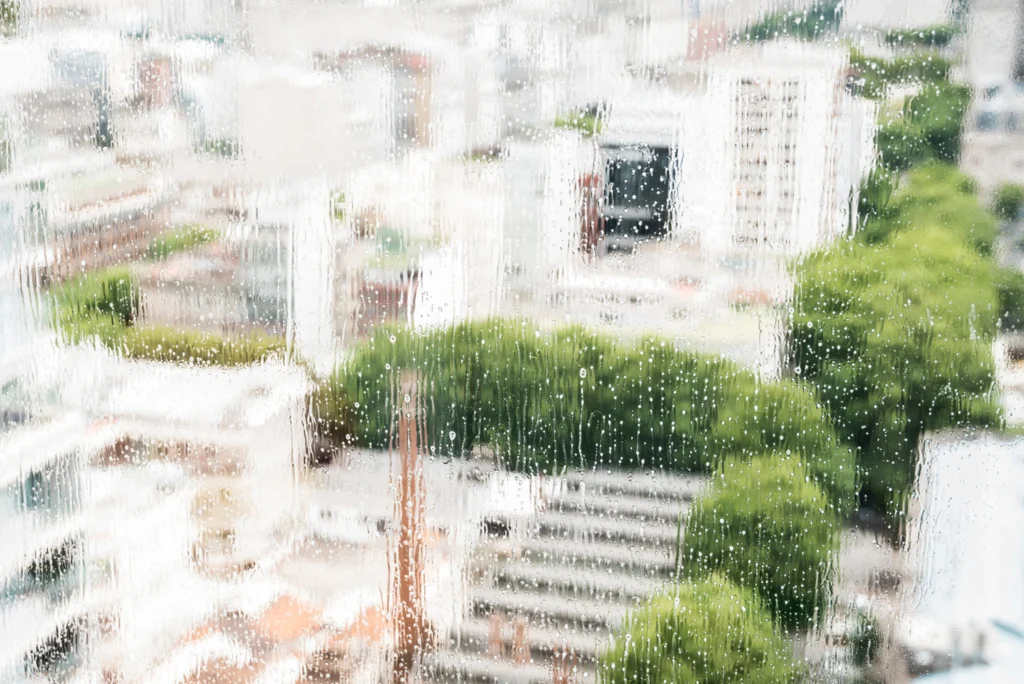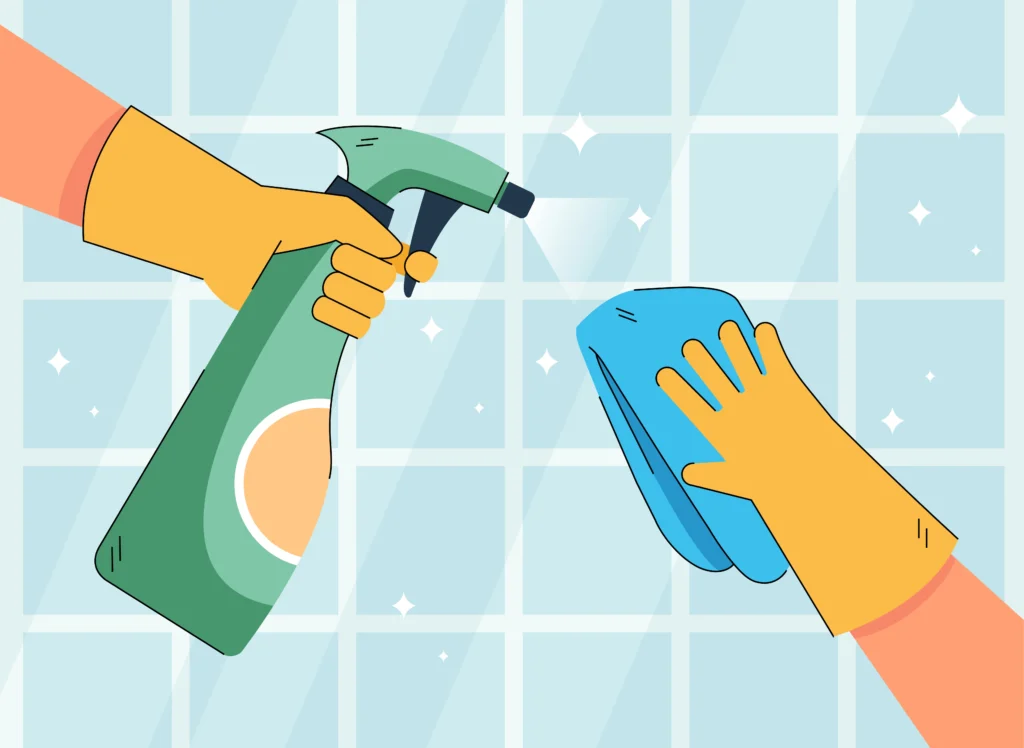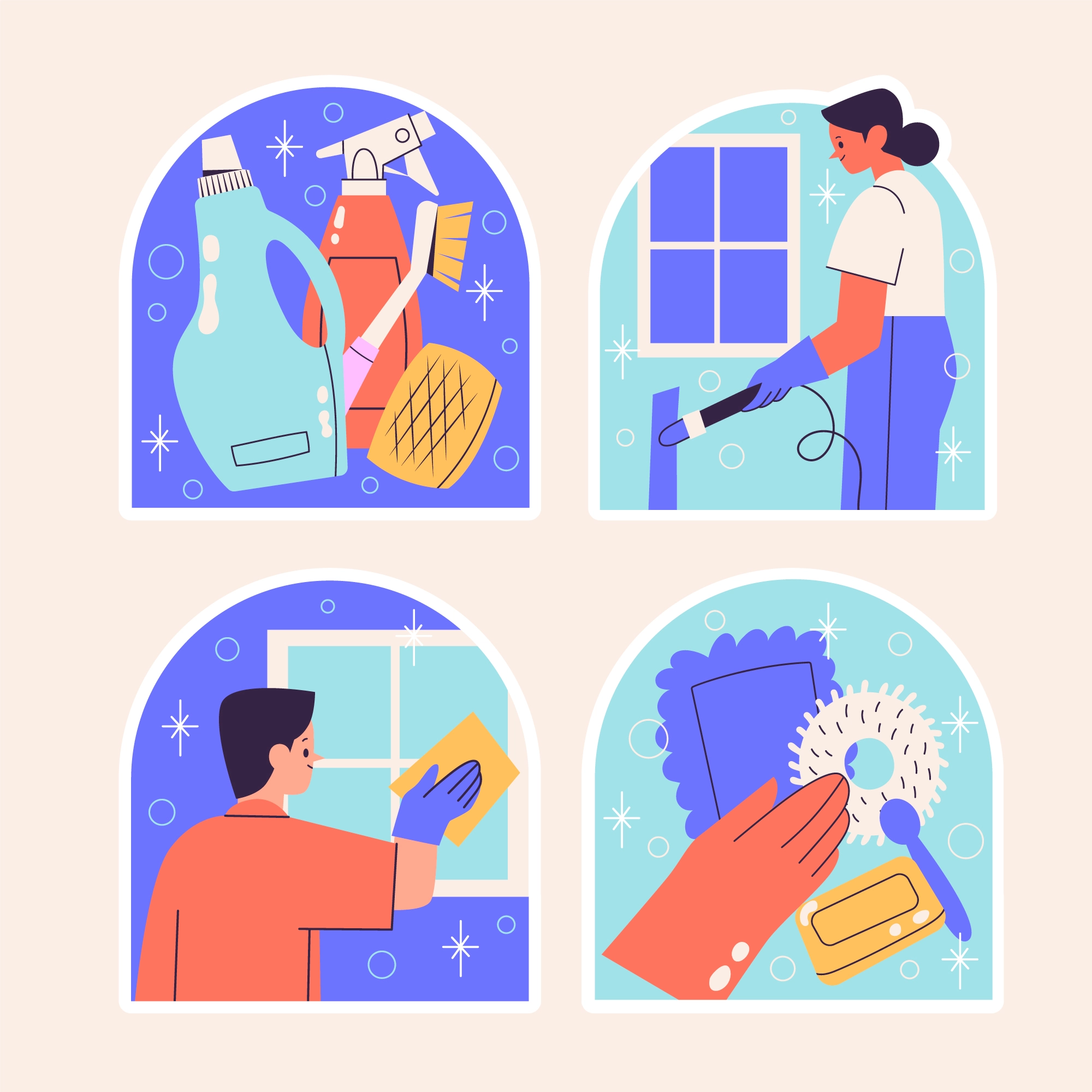Introduction: Why Water Stains Happen and Why You Should Remove Them
Water stains on glass are the bane for spotless homes. Whether it’s your shower floor, bathroom cloudy mirrors, outside windows, or glass railings, those stubborn white spots can make even the cleanest space look dull..
But what exactly are water stains? Unlike simple dust or smudges, these spots are usually mineral deposits left behind when hard water evaporates. If you live in an area with high mineral content like calcium and magnesium, every drop can dry into a dull, chalky mark that ordinary cleaning often can’t remove.
If left untreated, hard water stains can build up, dull the glass surface, and become more challenging to clean over time. They dull your bathroom’s shine, block your windows’ views, and can even damage decorative glass panels around your home.
With the right methods, tools, and habits, you can restore your glass to a crystal-clear shine. This guide will show you exactly how to get rid of water stains from glass, step by step, with expert-approved methods that really work. Whether you’re dealing with light spots or years of buildup, you’ll find tips here to get the job done easily and safely.
What Causes Water Stains on Glass?

Main cause: Hard Water
Most water stains are caused by hard water that has a high mineral content, especially calcium and magnesium. When water droplets land on glass and dry up, these minerals get left behind, creating visible white spots.
Common Places You’ll Find Water Stains
- Shower doors and screens: Constant splashes and steam make bathrooms the number one trouble spot.
- Bathroom mirrors: Splash marks from washing your face or brushing your teeth can leave stubborn spots.
- Exterior windows: Rain mixed with minerals or sprinkler systems can cause streaks and spots.
- Glass railings and patio doors: Outdoor glass is exposed to rain, sprinklers, or ocean spray.
Why They Get Worse Over Time
If you don’t clean hard water stains promptly, layers of minerals build up. Over time, this buildup can bond to the glass and may even cause permanent imprints..
Tools and Supplies You’ll Need
Before tackling tough stains, gather these simple supplies:
- White vinegar
- Baking soda
- Lemon juice (optional)
- Commercial lime scale remover (like CLR or Lime-A-Way)
- Soft microfiber cloths
- Non-abrasive sponge
- Rubber gloves
- Spray bottle
- Squeegee
- Old toothbrush (for corners)
Bonus Tip: Use Distilled water for rinsing, so no new mineral spots are left behind!
How to Get Rid of Water Stains from Glass: Basic Method
For light to moderate spots, you don’t need strong chemicals. A simple DIY approach often does the trick.
1. Mix a Vinegar Solution
White vinegar is a natural, gentle acid that dissolves mineral deposits.
How to use it:
- Mix equal parts white vinegar and warm water in a spray bottle.
- Spray generously on the stained glass.
- Let it sit for at least 5–10 minutes. For heavier stains, wait 20 minutes.
2. Scrub Gently
Use a soft sponge or microfiber cloth to scrub the spots. Don’t use anything abrasive — it can scratch the glass surface.
3. Rinse Well
Use clean water to rinse away the loosened minerals.
Pro tip: If you have hard water, rinse with distilled water to prevent new spots.
4. Dry and Polish
Dry with a clean microfiber cloth or use a squeegee for larger glass panels. This prevents fresh mineral spots as the glass dries.
How to Tackle Stubborn Water Stains
Some spots don’t vanish with vinegar alone. Here’s how to remove tougher buildup-
Method 1: Vinegar and Baking Soda Paste
This natural combo is slightly abrasive — great for tackling mineral rings.
How to use it:
- Make a paste with baking soda and a few drops of vinegar or water.
- Dab the paste onto the stains.
- Let it sit for 10–15 minutes.
- Scrub gently with a non-abrasive sponge.
- Rinse thoroughly and dry.
Method 2: Lemon Juice Boost
Lemon juice is another mild acid. For extra cleaning power, add it to your vinegar mix or rub lemon halves directly on the stains.
Method 3: Commercial Lime Remover
If natural methods fail, use a store-bought lime or calcium remover like CLR.
How to use it safely:
- Wear gloves and follow the label instructions.
- Apply only to glass — avoid metal frames or stone tiles that can be damaged by strong acids.
- Rinse thoroughly with plenty of water.
Pro Methods for Outside Windows
Hard water stains on exterior windows often need a bit more care. Here’s how pros do it safely:
Use a Pure Water System
Professional window cleaners often use a water-fed pole with purified water. The soft water rinses minerals away with zero streaks — no drying needed. You can check the best window cleaners for outside windows for best results.
Soft-Bristle Brush and Squeegee
If you’re tackling this yourself:
- Use a telescopic pole with a soft-bristle brush.
- Scrub gently with your vinegar solution.
- Rinse with plain water or a hose.
- Finish with a squeegee in smooth, overlapping strokes.
Avoid Midday Sun
Direct sun dries cleaner too fast, leaving streaks and spots. Clean on a cloudy day for best results.
How to Get Rid of Water Stains on Mirrors
Spray with a vinegar solution
Mix equal parts white vinegar and water in a spray bottle, then spray generously over the stained areas. Let it sit for 1–2 minutes to loosen mineral buildup.
Wipe in gentle circles
Use a soft microfiber cloth to wipe the mirror in circular motions. This helps remove stains without scratching the surface.
Tackle tough spots with toothpaste
For stubborn marks, apply a small dab of non-gel toothpaste directly onto the stain. Gently rub with your cloth — it works like a mild polish to lift the residue.
Rinse lightly
Dampen a clean cloth with water to remove any remaining vinegar or toothpaste.
Buff to a clear shine
Use a dry microfiber or lint-free cloth to polish the mirror, leaving it streak-free and sparkling.
With these tips, you can make your bathroom smells amazing and make your bathroom shining for a long lasting period.
How to Prevent Water Stains from Coming Back
Cleaning is not the only thing, prevention keeps glass sparkling longer.
Wipe Down Shower Doors Daily
Keep a small squeegee or microfiber cloth in your shower. After each use, wipe water drops off the doors. It takes 30 seconds but saves hours of scrubbing later!
Use a Water Repellent
You can use water repellents, like Rain-X, can be safely used on shower doors or exterior glass. They make water dry up easily and slide off instead of drying into spots.
Keep Sprinklers in Check
If you have sprinklers near windows or glass doors, adjust them so they don’t spray directly onto the glass.
Pro Tips for Streak-Free Results

Streak-free glass isn’t just about using the right cleaner, it’s also about technique, timing, and finishing touches. Follow these expert tips to keep your glass surfaces sparkling clear and beautifully polished.
1. Use Distilled Water for the Final Rinse
Tap water, especially in hard water regions, contains minerals like calcium and magnesium that cause those dreaded white spots and streaks. Even after you clean the glass thoroughly, rinsing with regular tap water can undo your efforts.
Why distilled water works:
- It’s purified and free from minerals.
- It leaves zero residue behind, especially helpful on exterior windows or in bathrooms with heavy moisture.
- It’s perfect for final rinses after using any cleaner, especially when drying in direct sunlight where evaporation happens quickly.
How to use it:
- Fill a clean spray bottle with distilled water.
- After scrubbing or cleaning, do a final rinse using distilled water.
- Dry immediately with a clean microfiber cloth or squeegee to prevent airborne dust from sticking to the wet surface.
2. Never Use Abrasive Pads
Glass is smooth. It might seem tempting to scrub away stubborn water stains with steel wool, scouring pads, or abrasive scrubbers, but these tools can do more harm than good.
What to avoid:
- Steel wool
- Rough scrubber sponges
- Magic erasers on glossy surfaces
Why it matters:
- These materials can leave tiny scratches on the glass surface.
- Once scratched, the glass becomes even more prone to catching dirt, dust, and minerals, making future stains worse and harder to remove.
- Scratched glass also dulls the appearance and may require professional restoration or replacement.
Instead, use:
- Soft microfiber cloths
- Non-abrasive sponges
- Old toothbrushes for tight corners
Always clean with a light touch. Let your cleaning solution do the work, not excessive force.
3. Wipe Edges, Corners, and Window Tracks Thoroughly
One of the most overlooked steps in glass cleaning is drying the edges and tracks. After you’ve cleaned the glass itself, water can pool in corners or trickle down from the edges, leaving behind streaks or mineral deposits.
Here’s how to prevent that:
- Use the corner of a folded microfiber cloth to reach into edges and seams.
- Dry horizontal window tracks or frames where water collects.
- Pay extra attention to areas where vertical and horizontal surfaces meet — these trap moisture that drips out later.
Drying these hidden areas not only gives your glass a spotless look but also helps prevent mold, mildew, or rust from forming in metal frames or sliding mechanisms.
4. Clean Regularly to Avoid Buildup
One of the most effective ways to maintain streak-free glass is to clean it consistently, not just when stains are visible. When left untreated, mineral deposits can bond with the glass surface and become nearly impossible to remove without professional help.
Maintenance tips:
- Do a light cleaning or wipe-down every 1–2 weeks in high-use areas (like shower glass).
- Use a squeegee after every shower to prevent water droplets from drying on the glass.
- Do a monthly deep clean using the vinegar method to prevent buildup.
- Keep microfiber cloths handy in the bathroom and kitchen for quick spot-treating.
Why it helps:
Keeps your home looking polished and fresh with minimal effort.
Prevents etching and permanent stains.
Reduces the time and effort needed in deep cleaning.
H2: When to Call a Professional
If your glass has years of stubborn buildup, or you’re cleaning large exterior windows high off the ground, consider hiring professionals. They’ll handle the job faster and in a safer way.
Professional cleaning services like Mesh Maids provides services such as deep cleaning. If you face any issue while cleaning your home, do not hesitate to contact us.
Conclusion: Clear Glass, No More Spots
Hard water spots may dull your beautiful glass. With simple vinegar, baking soda, a squeegee, and a little elbow grease, you can restore sparkle to shower door, mirrors, and windows and keep them looking bright for years.
Wipe down glass surfaces daily, address small stains before they become permanent, and don’t let mineral buildup take over your home’s sparkle. To make the glass spotless only deep cleaning once in a year is not the only solution. Consistency is the key.
Feeling overwhelmed or short on time? Book your professional cleaning with Mesh Maids today and enjoy spotless home.
